上海交通大学:《现代控制理论》课程教学资源(讲稿)Chapter 2 Mathematic Description of Systems

Chapter 2 2 Chapter 2 Mathematic Description of Systems Objectives: Classification of systems State variable description State space model of linear systems Linear-time-invariant systems 。Linearization Transfer function and state space model Theory
Chapter 2 Mathematic Description of Systems Objectives: • Classification of systems • State variable description • State space model of linear systems • Linear-time-invariant systems • Linearization • Transfer function and state space model Chapter 2 2
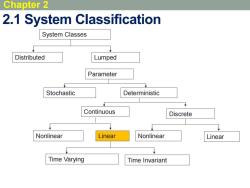
Chapter 2 2.1 System Classification System Classes Distributed Lumped Parameter Stochastic Deterministic Continuous Discrete Nonlinear Linear Nonlinear Linear Time Varying Time Invariant
2.1 System Classification System Classes Distributed Lumped Parameter Deterministic Time Invariant Linear Discrete Stochastic Continuous Time Varying Nonlinear Linear Nonlinear 3 Chapter 2
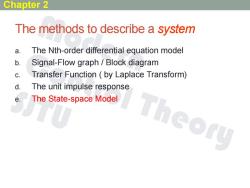
Chapter 2 The methods to describe a system a. The Nth-order differential equation model b. Signal-Flow graph Block diagram C. Transfer Function by Laplace Transform) d. The unit impulse response e The State-space Model Theory
The methods to describe a system a. The Nth-order differential equation model b. Signal-Flow graph / Block diagram c. Transfer Function ( by Laplace Transform) d. The unit impulse response e. The State-space Model Chapter 2

Chapter 2 Signal flowgraph/ Differential Equations State Equations Block diagram Impulse response Transfer function SJTU Theory Frequency response
Differential Equations State Equations Signal flowgraph/ Block diagram Impulse response Transfer function Frequency response Chapter 2
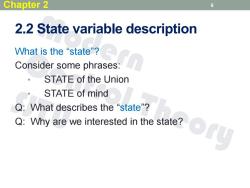
Chapter 2 6 2.2 State variable description Vhat is the“state"?e Consider some phrases: 。STATE of the Union STATE of mind。 Q:What describes the "state"? Q:Why are we interested in the state?
6 2.2 State variable description What is the “state”? Consider some phrases: • STATE of the Union • STATE of mind Q: What describes the “state”? Q: Why are we interested in the state? Chapter 2
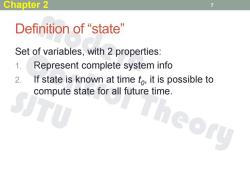
Chapter 2 7 Definition of“state Set of variables,with 2 properties: 1. Represent complete system info 2. If state is known at time to,it is possible to compute state for all future time. "Theory
7 Definition of “state” Set of variables, with 2 properties: 1. Represent complete system info 2. If state is known at time t0 , it is possible to compute state for all future time. Chapter 2
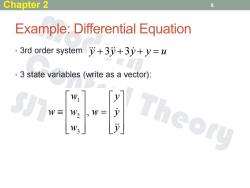
Chapter 2 8 Example:Differential Equation 3rd order system++3y=u 3 state variables (write as a vector): W≡ W2 ,w= W3 Theory
8 Example: Differential Equation • 3rd order system • 3 state variables (write as a vector): y y y y u 3 3 1 2 3 , w y w w w y w y Chapter 2

Chapter 2 9 Example:Mass-spring-damper 2 state variables: mass position M 。mass velocity K W SJTU B
9 Example: Mass-spring-damper B K M x F 2 state variables: • mass position • mass velocity Chapter 2

Chapter 2 10 Example:Mass-spring-damper 。2nd-order model M K M优+Bx+Kx=F SJTU B X
10 Example: Mass-spring-damper • 2nd-order model Mx Bx Kx F B K M x F Chapter 2
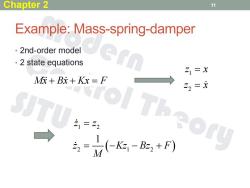
Chapter 2 11 Example:Mass-spring-damper 。2nd-order model 。2 state equations 21=X M优+Bx+Kx=F 22=X T 21=22 → ol Theory -人k-:+)
11 Example: Mass-spring-damper • 2nd-order model • 2 state equations 1 2 2 1 2 1 z z z Kz Bz F M 1 2 z x z x Mx Bx Kx F Chapter 2
按次数下载不扣除下载券;
注册用户24小时内重复下载只扣除一次;
顺序:VIP每日次数-->可用次数-->下载券;
- 上海交通大学:《现代控制理论》课程教学资源(讲稿)Chapter 1 Introduction Morden Control Theory(主讲:鲍其莲).pdf
- 上海交通大学:《精密仪器设计》课程教学大纲(电气信息类测控技术与仪器专业).docx
- 兰州交通大学:《电气化铁道供电系统与设计》课程教学资源(教案讲义,打印版)电气化铁道供电系统的构成.pdf
- 兰州交通大学:《电气化铁道供电系统与设计》课程教学资源(教案讲义)高速电气化铁路接触网.pdf
- 兰州交通大学:《电气化铁道供电系统与设计》课程教学资源(教案讲义)铁道供电系统保护及远动控制.pdf
- 兰州交通大学:《电气化铁道供电系统与设计》课程教学资源(教案讲义)铁道供电系统的仿真研究及其智能测试.pdf
- 兰州交通大学:《电气化铁道供电系统与设计》课程教学资源(教案讲义,打印版)电气化铁道供电系统的供电方式(负责人:李彦哲).pdf
- 兰州交通大学:《电气化铁道供电系统与设计》课程教学资源(教案讲义,打印版)铁道供电系统的绝缘水平及防雷接地措施.pdf
- 兰州交通大学:《电气化铁道供电系统与设计》课程教学资源(教案讲义,打印版)电气化铁道供电系统的牵引变电所.pdf
- 兰州交通大学:《电气化铁道供电系统与设计》课程教学资源(实验指导)供电技术知识——中央信号回路.pdf
- 兰州交通大学:《电气化铁道供电系统与设计》课程教学资源(实验指导)供电技术知识——断路器的控制回路.pdf
- 兰州交通大学:《电气化铁道供电系统与设计》课程教学资源(实验指导,打印版)绝缘油耐压实验.pdf
- 兰州交通大学:《电气化铁道供电系统与设计》课程教学资源(实验指导,打印版)介质损耗角的测量.pdf
- 兰州交通大学:《电气化铁道供电系统与设计》课程教学资源(实验指导,打印版)测量绝缘电阻和吸收比.pdf
- 兰州交通大学:《电气化铁道供电系统与设计》课程教学资源(实验指导,打印版)电流互感器.pdf
- 兰州交通大学:《电气化铁道供电系统与设计》课程教学资源(实验指导,打印版)电压互感器.pdf
- 兰州交通大学:《电气化铁道供电系统与设计》课程教学资源(实验指导,打印版)各主要电气设备的外形及结构.pdf
- 兰州交通大学:《电气化铁道供电系统与设计》课程教学资源(试卷习题)2011电气化铁道供电系统与设计试卷B.doc
- 兰州交通大学:《电气化铁道供电系统与设计》课程教学资源(试卷习题)2010电气化铁道供电系统与设计试卷A.doc
- 兰州交通大学:《电气化铁道供电系统与设计》课程教学资源(试卷习题)2009电气化铁道供电系统与设计试卷.doc
- 上海交通大学:《现代控制理论》课程教学资源(讲稿)Chapter 3 Linear algebra.pdf
- 上海交通大学:《现代控制理论》课程教学资源(讲稿)Chapter 4 State Space Solutions and Realizations.pdf
- 上海交通大学:《现代控制理论》课程教学资源(讲稿)Chapter 5 Stability Analysis.pdf
- 上海交通大学:《现代控制理论》课程教学资源(讲稿)Chapter 6 Controllability and Observability.pdf
- 上海交通大学:《现代控制理论》课程教学资源(讲稿)Chapter 7 State Feedback and State Estimator.pdf
- 上海交通大学:《现代控制理论》课程教学资源(讲稿)Chapter 8 Fundamentals of Optimal Control.pdf
- 华东理工大学:《信号与系统》课程教学资源(试卷习题)模拟试题1试题.pdf
- 华东理工大学:《信号与系统》课程教学资源(试卷习题)模拟试题1参考答案.pdf
- 华东理工大学:《信号与系统》课程教学资源(试卷习题)模拟试题2参考答案.pdf
- 华东理工大学:《信号与系统》课程教学资源(试卷习题)模拟试题2试题.pdf
- 华东理工大学:《信号与系统》课程教学资源(试卷习题)样题1试题.pdf
- 华东理工大学:《信号与系统》课程教学资源(试卷习题)样题1答案.pdf
- 华东理工大学:《信号与系统》课程教学资源(试卷习题)样题2试题.pdf
- 华东理工大学:《信号与系统》课程教学资源(试卷习题)样题2答案.pdf
- 华东理工大学:《信号与系统》课程教学资源(习题解答)第1章 信号与系统.pdf
- 华东理工大学:《信号与系统》课程教学资源(习题解答)第2章 连续系统的时域分析.pdf
- 华东理工大学:《信号与系统》课程教学资源(习题解答)第3章 离散系统的时域分析.pdf
- 华东理工大学:《信号与系统》课程教学资源(习题解答)第4章 连续系统的频域分析.pdf
- 华东理工大学:《信号与系统》课程教学资源(习题解答)第5章 连续系统的s域分析.pdf
- 安徽理工大学:《智能控制及仿真》课程教学大纲 Intelligent Control Theory and simulation(负责人:陈静).pdf
